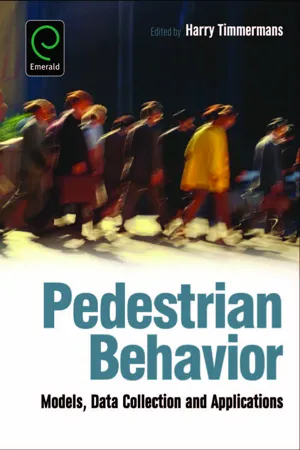
- 360 pages
- English
- PDF
- Available on iOS & Android
About This Book
Studies of pedestrian behaviour have recently gained a lot of attention in a variety of disciplines, including urban planning, transportation, civil engineering, computer science/artificial intelligence and applied physics. Various kinds of models for simulating pedestrian behaviour have been suggested. Moreover, new technologies have been used to collect data about pedestrian movement patterns. The aim of this book is to document these new developments in research and modelling approaches. In this book, leading scholars representing different modelling approaches and fields of application have written chapters about the analysis and modelling of pedestrian movement patterns. Modelling approaches include cellular automata models, fluid dynamics, discrete choice models, rule-based models, multi-agent models and models of bounded rationality. The chapters illustrate that these model can be successfully used to simulate phenomena such as lane formation, crowding, activity-patterns, path decisions, micro-behaviour, impulse buying and store choice behaviour. Finally, the book contains some interesting application of this body of research. These chapters and paragraphs demonstrate the applied potential of models of pedestrian behaviour.
Frequently asked questions
Information
Table of contents
- Front cover
- Pedestrian behavior: Models, Data Collection and Applications
- Copyright page
- Contents
- List of Contributors
- Introduction
- Chapter 1. Pedestrians Choices
- Chapter 2. Empirical Results for Pedestrian Dynamics and their Implications for Cellular Automata Models
- Chapter 3. Modeling, Simulating, and Visualizing Crowd Dynamics with Computational Tools Based on Situated Cellular Agents
- Chapter 4. Modeling Impulse and Non-Impulse Store Choice Processes in a Multi-Agent Simulation of Pedestrian Activity in Shopping Environments
- Chapter 5. Modeling Pedestrian Movement in Shopping Street Segments
- Chapter 6. Simulating Pedestrian Route-Choice Behavior under Transient Traffic Conditions
- Chapter 7. Modeling and Simulating Pedestrian Shopping Behavior Based on Principles of Bounded Rationality
- Chapter 8. A Model of Time Use and Expenditure of Pedestrians in City Centers
- Chapter 9. A Novel Calibration Approach of Microscopic Pedestrian Models
- Chapter 10. Crowd Dynamics Phenomena, Methodology, and Simulation
- Chapter 11. The MATSim Network Flow Model for Traffic Simulation Adapted to Large-Scale Emergency Egress and an Application to the Evacuation of the Indonesian City of Padang in Case of a Tsunami Warning
- Chapter 12. Comparative Study of Pedestrian Behavior in Central Shopping Areas of East Asian Cities
- Chapter 13. The Pedestrian Itinerary-Purposes, Environmental Factors and Path Decisions
- Chapter 14. Visitors’ Behavior in World Expo 2010 Shanghai: An Application of Discrete Choice Models and Web-Based Survey
- Chapter 15. Measurement of Pedestrian Movements: A Comparative Study on Various Existing Systems